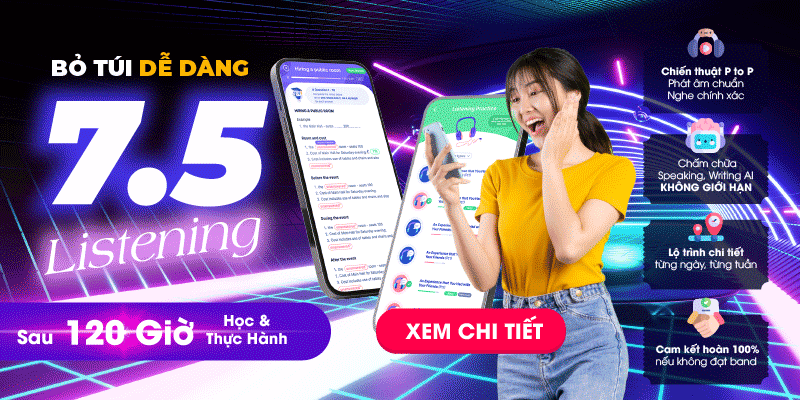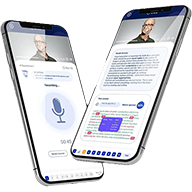IELTS listening numbers and letters practice là một kỹ năng quan trọng trong phần Listening của kỳ thi IELTS. Để tránh mất điểm không đáng có, bạn học cần luyện tập chiến lược nghe hiệu quả, giúp cải thiện khả năng nắm bắt chi tiết như số điện thoại, địa chỉ, ngày tháng và chính tả tên.
Ở bài viết này, Edmicro sẽ cung cấp cho bạn các mẹo hữu ích để giúp bạn tự tin hơn trong bài thi IELTS nhé!
IELTS Listening Numbers And Letters Practice là gì?
Dạng bài IELTS Listening Numbers And Letters Practice tập trung vào việc nghe và nhận diện các số và chữ cái, thường xuất hiện trong Listening section 1 của bài thi IELTS.
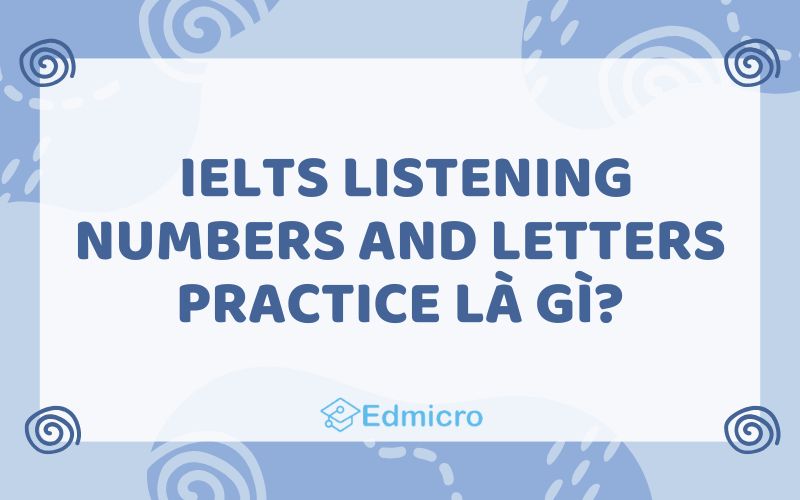
Đây là phần dễ nhất nhưng lại yêu cầu độ chính xác cao vì bạn thường phải nghe những chi tiết như số điện thoại, ngày tháng, địa chỉ, và cách đánh vần tên riêng. Dạng bài Listening numbers and letters là một phần của dạng bài lớn là Completion (Điền từ vào chỗ trống)
Các dạng thông tin thường gặp ở dạng bài này bao gồm:
- Số điện thoại: Dãy số được đọc liên tục.
- Ngày tháng
- Giá cả: Các số liên quan đến tiền tệ, chẳng hạn như giá sản phẩm.
- Số hiệu: Như số nhà, mã bưu điện.
Xem thêm: IELTS Listening Part 4 – Các Dạng Bài Và Cách Làm Chi Tiết
Từ vựng thường xuất hiện trong IELTS Listening Numbers and Letters Practice
Dạng bài IELTS Listening Numbers and Letters Practice yêu cầu bạn nghe và viết chính xác các con số, chữ cái xuất hiện trong bài nghe. Để làm tốt dạng bài này, bạn cần nắm vững các từ vựng liên quan đến số, chữ cái và các tình huống thường gặp. Cùng Edmicro khám phá những từ vựng quan trọng nhé!
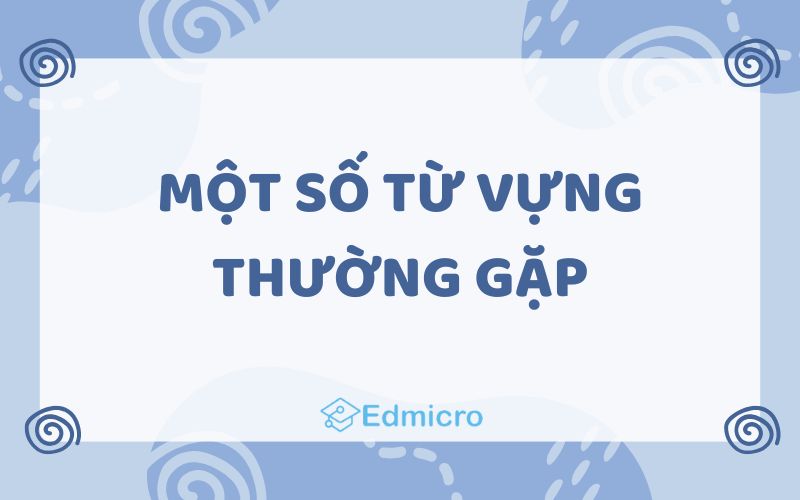
Từ vựng liên quan đến số (Numbers)
Để làm tốt phần nghe về số trong IELTS, bạn cần nắm vững các từ vựng sau:
| Dates and Times (Ngày tháng và thời gian) | Year: năm (ví dụ: 1995 – nineteen ninety-five) Century: thế kỷ (ví dụ: 21st century – thế kỷ 21) Decade: thập niên (ví dụ: 1980s – những năm 1980) Time: thời gian (ví dụ: 4:30 – four thirty) Date of birth: ngày sinh Deadline: hạn chót Expiration date: ngày hết hạn Birthday: ngày sinh nhật |
| Money (Tiền tệ) | Price: giá cả (ví dụ: $5.50 – five dollars fifty) Discount: giảm giá (ví dụ: 20% discount – giảm giá 20%) Currency: đơn vị tiền tệ (ví dụ: dollar, pound, euro, yen) Total: tổng cộng Pounds: Bảng Anh Dollars: Tiền đô Euros: Tiền Châu Âu Fee: Chi phí |
| Measurements (Đo lường) | Length: chiều dài (ví dụ: 2 meters – hai mét) Weight: cân nặng (ví dụ: 50 kilograms – 50 kg) Distance: khoảng cách (ví dụ: 10 miles – 10 dặm) Speed: tốc độ (ví dụ: 60 km/h – 60km trên giờ) |
Từ vựng liên quan đến chữ cái (Letters)
Dưới đây là từ vựng liên quan đến Letters trong dạng bài IELTS Listening Numbers and Letters Practice:
| Alphabet (Bảng chữ cái) | Vowels: Nguyên âm (A, E, I, O, U) Consonants: Phụ âm (B, C, D, F, G, H,…) |
| Spelling Terms (Thuật ngữ đánh vần) | Spell: đánh vần Capital letter: chữ cái viết hoa (Ví dụ: “A” – chữ hoa) Lowercase letter: chữ cái viết thường (Ví dụ: “a” – chữ thường) Hyphen: dấu gạch nối (Ví dụ: “-“) Underscore: dấu gạch dưới (Ví dụ: “_”) Apostrophe: dấu nháy đơn (Ví dụ: “’”) Dash: dấu gạch ngang dài (Ví dụ: “—”) |
| Common Contexts (Ngữ cảnh thường gặp) | First name: tên riêng Last name / Surname: họ Middle name: tên đệm Username: tên đăng nhập (Ví dụ: john_doe123) Email address: địa chỉ email Password: mật khẩu |
| Punctuation Marks (Dấu câu) | Period / Full stop: dấu chấm (.) Comma: dấu phẩy (,) Colon: dấu hai chấm (:) Semicolon: dấu chấm phẩy (;) At symbol: dấu @ (dùng trong email) Forward slash: dấu gạch chéo (/) |
| Basic Address Components (Thành phần cơ bản của địa chỉ) | Address: địa chỉ Street: đường/phố (Ví dụ: “Main Street”) Avenue (Ave.): đại lộ (Ví dụ: “5th Avenue“) Road (Rd.): đường (Ví dụ: “Elm Road”) Lane: ngõ/hẻm (Ví dụ: “Green Lane”) Boulevard (Blvd.): đại lộ lớn (Ví dụ: “Sunset Boulevard”) Square: quảng trường (Ví dụ: “Trafalgar Square“) Court (Ct.): đường cụt hoặc nhỏ (Ví dụ: “Baker Court”) Building: tòa nhà (Ví dụ: “Empire Building”) Apartment (Apt.): căn hộ (Ví dụ: “Apt. 12B”) |
Xem thêm: Từ Vựng IELTS Listening Quan Trọng Phân Theo Chủ Đề
Cách luyện tập IELTS Listening Numbers And Letters
Luyện tập kỹ năng nghe số và chữ trong IELTS Listening là một phần quan trọng để đạt điểm cao. Dưới đây là một số cách để luyện tập hiệu quả mà Edmicro đã tổng hợp được:

Nghe và ghi chép:
- Nghe các bài tập IELTS Listening: Tìm kiếm các bài tập IELTS Listening trực tuyến hoặc trong sách luyện thi. Nghe bài và ghi chép các con số, chữ cái và tên riêng được nhắc đến.
- Tập trung vào từ khóa: Khi nghe, hãy chú ý đến các từ khóa liên quan đến số, như “number”, “date”, “time”, “address”, “phone number”, “card number”.
- Viết nhanh và chính xác: Luyện tập viết nhanh và chính xác các con số, chữ cái và tên riêng.
Tự tạo bài tập:
- Tạo các bài tập nghe: Tự tạo các bài tập nghe với các con số, chữ cái và tên riêng khác nhau. Nghe bài và ghi chép lại.
- Tăng độ khó: Tăng dần độ khó của các bài tập bằng cách sử dụng các con số phức tạp hơn, các tên riêng dài hơn hoặc tăng tốc độ phát âm.
Kiểm tra kết quả:
- So sánh với đáp án: Sau khi hoàn thành bài tập, so sánh kết quả của bạn với đáp án.
- Phân tích lỗi: Phân tích các lỗi sai để tìm ra nguyên nhân và cải thiện kỹ năng của mình.
Học từ vựng liên quan:
- Học các từ vựng về số, chữ cái và tên riêng để hiểu và ghi chép chính xác hơn.
- Sử dụng flashcards: Tạo các thẻ từ vựng để ôn tập bất cứ khi nào.
Bài tập vận dụng IELTS Listening Numbers and Letters practice
Cùng Edmicro làm bài tập dưới đây để nắm rõ cách làm của dạng bài này nhé!
Bài tập:
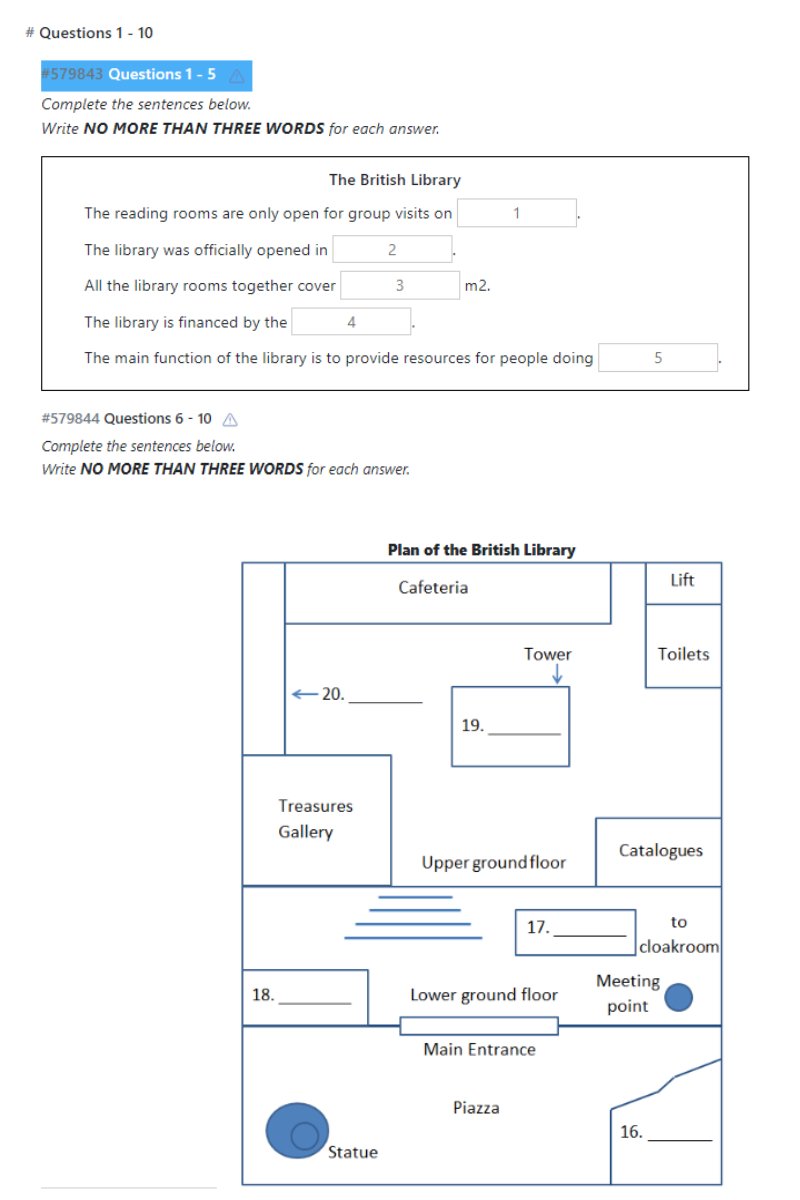
Đáp án:
| Câu | Đáp án | Câu | Đáp án |
|---|---|---|---|
| 1 | Sundays | 6 | Conference Centre/Conference Center |
| 2 | 1998 | 7 | information desk |
| 3 | 100,000 | 8 | bookshop |
| 4 | government | 9 | King’s Library/Kings Library |
| 5 | research | 10 | stamp display |
Audio transcript:
Good afternoon, ladies and gentlemen, and welcome to your very own tour of the British Library on this lovely afternoon. My name is Tony Walters and I’m your guide for today. Could I please see your tickets for the guided tour?
I’d also like to remind you that any tickets bought today do not include a visit to the reading rooms. I’m afraid we don’t do visits on Fridays – or any weekday during working hours, so as not to disturb the readers. But if you do want to see those rooms, the only day there are tours is on Sundays (Q1). So, I don’t want anyone to be disappointed about that today. OK? thank you.Right. We’ll start with a brief introduction As many of you know, this is the United Kingdom’s National Library and you can see that this is a magnificent modern building. It was first designed by Sir Colin St John Wilson in 1977, and inaugurated by Her Majesty the Queen more than twenty years later, in 1998 (Q2).
As you can see. the size is immense and the basements alone have 300 kilometres of shelving – and that’s enough to hold about 12 million books. The total floor space here is 100,000 (Q3) square metres and, as I’ll show you, the library houses a huge range of facilities and exhibition spaces, and it has a thousand staff members based here in the building – so, you can appreciate the scale of our operation.
In fact, this was the biggest publicly-funded building constructed in the United Kingdom last century. It is still funded by the government (Q4) as a national institution, of course, and it houses one of the most important collections in the world. The different items come from every continent and span almost 3000 years.
The library isn’t a public library, though you can’t just come in and join and borrow any of the books. Access to the collections is limited to those involved in carrying out research (Q5), so it’s really a huge reference library for that purpose, and anyone who wants to consult any materials that are kept here can formally apply to use the library reading rooms.
Right, well, here we are, standing at the Meeting Point on the lower ground floor just to the right of the Main Entrance. I’ve given you all a plan of the building so that we can orientate ourselves and get an idea of where we’ll be going. Now outside the Main Entrance you’ll see the wide Piazza with the stunning sculpture of Newton.
The sculptor was Paolozzi, but it’s based on the famous image by William Blake – and it’s definitely worth a closer look. On the other side of the Piazza from the statue is the Conference Centre (Q6), which is used for all kinds of international conventions we’ll take a quick look inside at the end of our tour.
Looking ahead of us now, you’ll see that we’re standing opposite the staircase down to the basement where you’ll find the cloakroom, and to the left of that, we have the information desk (Q7) where you can find out about any current exhibitions, the times of the tours and anything you need to know – if you don’t have a tour guide. As you can see, on this lower ground floor we also have a bookshop (Q8) that’s the area over to the left of the main entrance. You’ll be free to browse there when we get back to the ground floor
Now, opposite the main entrance on this floor we have the open stairs leading up to the upper ground floor. And at the top of them, in the middle of the upper ground floor, you can see a kind of glass-sided tower that rises all the way up through the ceiling and up to the first floor. This is called the King’s Library (Q9), it’s really the heart of the building, it was built to house the collection that was presented to the nation in 1823 by the King. You can see it from every floor above ground. When we go up there, you’ll find the library’s Treasures Gallery on the left. Can you find it on your plan? That’s the exciting one, so we’ll be visiting that first but we’ll also take a look at the stamp display (Q10) situated behind it, on the way to the cafe – a lot of people miss that. The Cafeteria runs along the back of the floor and, in the right-hand corner, you’ll find the lifts and toilets … ha, always good to locate them. The other main area on that floor is the Public Access Catalogue section and I’ll show you how that operates when we get up there …
Việc luyện tập IELTS Listening Numbers and Letters Practice không chỉ giúp bạn cải thiện kỹ năng nghe mà còn tăng khả năng nhận diện và phản ứng nhanh với các thông tin chi tiết như số điện thoại, địa chỉ, hay tên người. Kiên trì rèn luyện qua các bài tập thực tế, sử dụng nguồn tài liệu chất lượng và luyện nghe thường xuyên sẽ giúp bạn tự tin hơn trong bài thi IELTS Listening. Edmicro chúc bạn học tốt!
Xem thêm:

